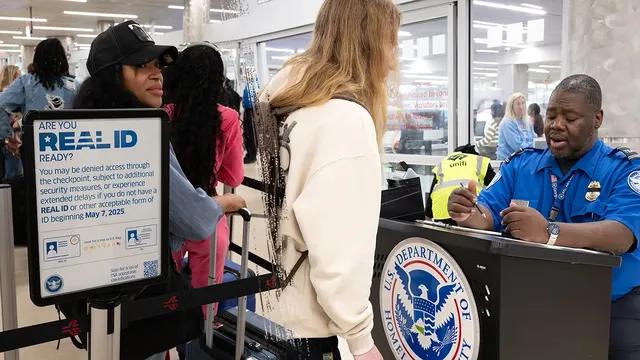
Travelers can still fly without REAL ID but face extra scrutiny
2025-05-08 11:00- The REAL ID Act enforcement began, requiring travelers to have compliant IDs to fly domestically.
- Travelers lacking REAL IDs can still board flights but will face additional screening at security.
- The implementation follows two decades of delays and aims to enhance air travel security.
Express your sentiment!
Insights
On May 7, 2025, in the United States, enforcement of the REAL ID Act commenced, impacting travelers in need of domestic flights. The head of Homeland Security, Kristi Noem, reported that travelers lacking a compliant REAL ID identification would still be allowed to fly but would face enhanced scrutiny at security checkpoints. Approximately 81% of passengers already possess IDs that meet the new requirements; however, others experienced long lines as they rushed to obtain this necessary identification ahead of the deadline. The implementation followed more than two decades of delays since the REAL ID Act was signed into law in 2005, which aimed to enhance national security in the wake of the September 11 attacks. Noem highlighted that security checkpoints continue to accept alternative forms of identification, including passports and tribal IDs. Despite many citizens expressing frustration over needing to secure a REAL ID or go through additional vetting, it was emphasized that those without immediate travel plans may want to apply for their REAL ID at a later date. This is advised to avoid unnecessary congestion at application offices and maintain smoother airport operations as enforcement began. Transportation Security Administration (TSA) Administrator Adam Stahl added that anyone without the proper identification should give themselves extra time at the airport due to the likelihood of going through longer security processes. States have seen increased demand for REAL IDs, leading to extended hours at Department of Motor Vehicles offices to help accommodate the rush of applications ahead of the deadline. Critics of the enforcement suggest that it unfairly burdens everyday Americans by compelling them to modernize their identification without a clear need demonstrated prior to this measure. Still, officials view the REAL ID law not just as a hurdle but as a necessary step toward ensuring the safety and security of air travel in the country. As a part of the ongoing security measures, the TSA has reaffirmed its commitment to facilitating travel while reinforcing the integrity of identity verification processes. This transition, although met with some resistance and complaints, highlights the evolving landscape of security regulations in a post-9/11 world, indicating a significant moment in the regulation of identification standards in air travel.
Contexts
The REAL ID Act was passed by the United States Congress in 2005 as a response to the 9/11 terrorist attacks, aiming to establish minimum security standards for state-issued driver's licenses and identification cards. The law aimed to enhance national security by ensuring that only individuals with verified identities could obtain these forms of identification. The Act mandates that states comply with federal standards by issuing cards that meet specific security and authentication criteria, thus preventing identity fraud and misuse of identification. Compliance is essential for individuals wishing to access federal facilities and board commercial flights, creating a direct connection between compliance with the REAL ID standards and everyday activities of American citizens. Implementation of the REAL ID Act has been a gradual process, with states given several extensions to meet the requirements. Initially, the deadline for full compliance was set for 2008, but as various states faced challenges ranging from funding to public opposition, the deadline was extended multiple times. This led to a patchwork of compliance across the country, where some states adopted the standards while others did not, often requiring residents to present alternative forms of identification. As the deadlines continued to shift, advocacy for increased education and outreach became crucial in ensuring that citizens understood the changes and what was required of them in terms of obtaining compliant IDs. The implementation of the REAL ID Act has faced criticism from various quarters. Privacy concerns have been raised regarding the collection and storage of personal data required to obtain a REAL ID-compliant license, as well as potential disparities faced by those who are unable or unwilling to provide the necessary documentation. In addition, it has been argued that the Act disproportionately affects low-income individuals and marginalized communities, raising questions about the equitable access to identification. The Department of Homeland Security (DHS) has worked to address these concerns by providing guidance to states and promoting outreach to ensure that the public is aware of the provisions of the Act. As of May 2025, the majority of states have complied with REAL ID requirements, and individuals are encouraged to ensure that their identification is compliant, especially with travel regulations becoming increasingly stringent. States continue to implement new standards, and the DHS remains vigilant in enforcing compliance to improve security measures without compromising the access and fairness expected in the issuance of personal identification. Overall, the history of REAL ID Act implementation reflects ongoing negotiations between ensuring national security interests and safeguarding individual privacy and accessibility.